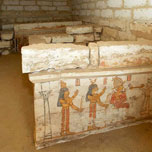The Virtual Museum of the UB includes a virtual tour through the archaeological site of Oxyrhynchus

The Virtual Museum of the University of Barcelona expands the section of virtual visits with a virtual tour through the archaeological site of Oxyrhynchus, located in the modern city of El-Bahnasa, at approximately 190 kilometres south of Cairo. In 1992, the UB reached an agreement with the Egyptian Antiquities Organization to implement the Archaeological Mission to Oxyrhynchus, which has been directed by Dr. Josep Padró, professor of Ancient History at the UB and president of the Catalan Egyptology Society. In 2002, the Mission fell exclusively to the University of Barcelona, with the collaboration of several public and private institutions, such as the Catalan Ministry of Culture.

The Virtual Museum of the University of Barcelona expands the section of virtual visits with a virtual tour through the archaeological site of Oxyrhynchus, located in the modern city of El-Bahnasa, at approximately 190 kilometres south of Cairo. In 1992, the UB reached an agreement with the Egyptian Antiquities Organization to implement the Archaeological Mission to Oxyrhynchus, which has been directed by Dr. Josep Padró, professor of Ancient History at the UB and president of the Catalan Egyptology Society. In 2002, the Mission fell exclusively to the University of Barcelona, with the collaboration of several public and private institutions, such as the Catalan Ministry of Culture.
Oxyrhynchus was the capital of the 19th Upper Egyptian Nome (an administrative division), which in ancient Egypt had the Pharaonic name of Per-Medjed. During the Saite period (664-525 BC) it became an important city. When Alexander the Great conquered Egypt (332 BC), Per-Medjed attracted a large number of Greek colonists, who gave it the name of Oxyrhynchus. The city maintained its importance during the Roman and Christian-Byzantine periods, and only after the Arab conquest, in 640 AD, did Oxyrhynchus begin to decline.
The ruins of Oxyrhynchus were discovered by Vivant Denon during Napoleonʼs Egyptian campaign (1799-1802). The first excavations began in 1897, but numerous looters and treasure-hunters also ransacked the site, attracted by the big amounts of papyri that could be found there. In 1982, a tomb from the Saite period was discovered and the Egyptian Antiquities Organization initiated official excavations, signing an agreement with the University of Barcelona ten years later. The expedition aims to study the structure and the monuments of the city at different times.
The virtual tour has received the support of Dr. Josep Padró, who has written the texts and selected the images.
